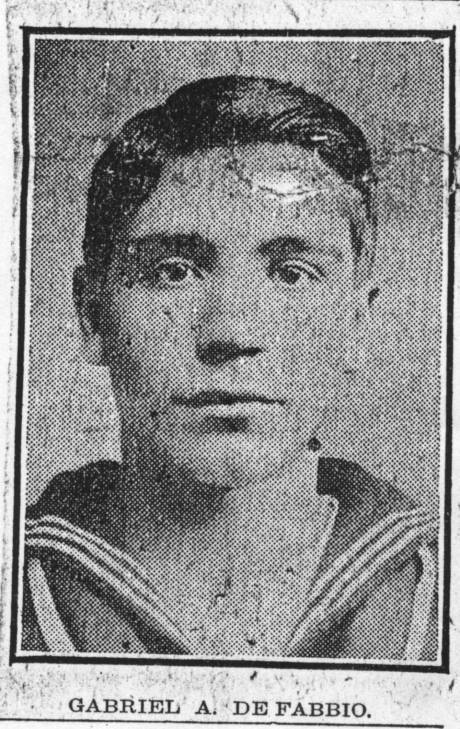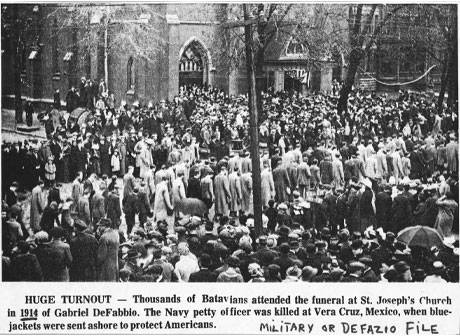
The battle at Vera Cruz, Mexico, on April 23, 1914, would prove to be an unfortunate forerunner of World War I. President Woodrow Wilson was concerned when General Victoriano Huerta overthrew Mexico’s government. The President tried to intervene suggesting an armistice. General Huerta refused all attempts of settlements by the United States. As a result in April 1914, US troops were sent to the Mexican border. The troops included a young man from Batavia, New York, Gabriel DeFabbio.
Gabriel was born in Italy, November 7, 1891. He came to this country with his mother, brother, and sister. His father had come to America ten years earlier. They originally settled in Holley before setting down roots in Batavia. Gabriel attended Batavia High School. In November 1908 Gabriel enlisted for a term of four years in the Navy. When his term expired he thought he would settle in Batavia, but his heart was in the Navy. After living in Batavia for four months and experiencing the life of a civilian, he decided to reenlist in the Navy. Gabriel’s previous experience advanced him to a gunner’s mate aboard the naval ship the USS New Jersey.
On April 14, 1914, Gabriel sent a letter to his parents saying he was headed for Mexico and he did not know if there would be a battle but he was ready if it happened. President Wilson ordered the troops to take over Vera Cruz.
As the USS New Jersey was docking, shooting began. In the commotion at the dock, the first eight men died in what became known as the battle of Vera Cruz. Young DeFabbio was one of them.
In Batavia, the parents of Gabriel received the following message from the Secretary of the Navy Josephus Daniel.
Thomas DeFabbio of No. 38 Center Street, Batavia, NY.
“Let me express my deep sympathy in your sad bereavement due to the loss of your son, Gabriel A. De Fabbio, at Vera Cruz Mexico, April 22, 1914. His patriotic courage has itself placed his name high on the roll of those to lay down their lives for their country.”
Both parents were overcome with grief, as was the entire community. Gabriel was survived by his parents Gabriel’s body was to be buried in Arlington National Cemetery.
Gabriel’s father, Thomas (Cosimo) had a specific request, however: he wanted his son’s body returned to Batavia for a public funeral and burial. He sent a message to the Secretary of the Navy and his request was honored.
There was a meeting of the Upton Post, G.A.R., (Grand Army of the Republic) in Ellicott Hall to discuss the plans for the military funeral of Gabriel. Many organizations were asked to participate in the arrangements of the funeral, the Women’s Relief Corps, Sons of Veterans as well as all civic organizations and societies in Batavia. Businesses were also asked to close their stores while the funeral was in progress. All flags were to be placed at half-staff to show respect for the soldier. An invitation was extended to all veterans of the Army and the Navy to attend the funeral.
The Spanish War Veterans selected three sailors from the Navy and three soldiers from the Army to serve as pallbearers. All military were dressed in full uniform.
A salute of seven guns was fired by the Spanish War Veterans upon the arrival of Gabriel’s remains as the train entered the station in Batavia. A cannon was used to notify the Batavians that his body had reached Batavia.
The pageant of patriotism was overwhelmingly demonstrated by three thousand Batavians and military persons who walked down Main Street to St. Joseph’s Catholic Church on the corner of Main Street and Summit Street. Only one thousand mourners could enter the church. The other two thousand stood on the steps and in the street waiting for the funeral to conclude.
President Wilson sent a beautiful wreath in memory of Gabriel DeFabbio. It was shipped to Batavia in a large wooden box. It was a wreath of galax leaves (galax leaves are a popular green in the floral industry) and Easter lilies. The card attached said the words, “The President.”
It was said that there had not been this much excitement since the dedication of the historic Holland Purchase Building today known as the Holland Land Office Museum.
On May 15, 1914, the marquees of The Grand and Family Theater advertised pictures showing the military funeral from the house to the grave. There were also slides showing the wreath sent by President Wilson.
This Batavia hero is honored with a historical marker on the lawn on the east side of the Holland Land Office Museum. The marker was erected one year after Gabriel’s death by the first company of the USS New Jersey.

